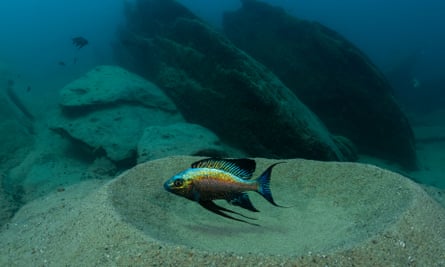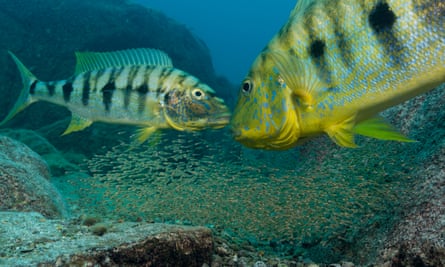Lake Tanganyika is the world’s longest freshwater lake. It stretches for more than 400 miles across central Africa and provides a home for some of the planet’s most extraordinary aquatic creatures. But this remarkable refuge – and its inhabitants – are under threat.
Pesticide runoffs from farms, sewage and overexploitation by collectors for the ornamental fish trade are devastating life in the lake. In particular, these forces are driving many populations of cichlid fish – of which there are more than 240 species in Lake Tanganyika – to extinction.

It is an alarming story that has been chronicled for the past 20 years by the Spanish photographer Angel Fitor – who has just won the portfolio award at the Wildlife Photographer of the Year exhibition, which opens at the Natural History Museum in London this week. His images reveal, in detail, the remarkable nature of the lake’s cichlids and the threats they face.
“Imagine fish that look after their babies with a care that is close to humans’ care for their children. It sounds like a fairytale. But that is what cichlids do,” Fitor told the Observer. This behaviour is revealed in stark detail in one of Fitor’s winning images. A female yellow sand cichlid is seen releasing its fry from the shelter of its mouth. Her young fish stay in her mouth for rest and protection, occasionally leaving to feed – but will dart back in at any hint of danger.
Another picture shows a large cichlid building a sand bower – a nest for spawning – with its mouth. Once complete, the cichlid performs an underwater dance to attract mates, a performance that usually takes place in the morning when the incoming sunlight best reflects off the fish’s iridescent scales.
Fitor said his interest in cichlids started in the 1970s when, as a child, he saw a bright yellow fish in a pet shop and fell in love with it. “Years later, I discovered it was a Tanganyika cichlid and I became obsessed with them – so when I became a photographer it was almost inevitable that I would focus on cichlids at Lake Tanganyika.”
The lake is the oldest of east Africa’s Great Lakes and is bounded by Tanzania, the Democratic Republic of the Congo, Burundi and Zambia. In recent years, the number of people living around the lake’s shores has risen to 10 million.
“It is a fairly big lake but that is a huge number of people to have living round it,” said Fitor. “A major attraction is the lake’s fish which is a key source of food, and the amounts that are now being caught is becoming a serious problem.
“In addition, there are significant losses of wild habitats which are being cleared to provide land for farming near its shores.”
The result is a triple whammy of overfishing, increasing amounts of sewage being dumped and rising levels of pesticides and nutrients running off from farms into streams that feed the lake. All are causing harm.

However, there is a further threat to the cichlids of Lake Tanganyika: the uncontrolled collection of many species to supply the world’s increasing demand for ornamental fish.
“The trade is essentially uncontrolled,” said Fitor. “Anyone can pay $100 for a collector’s licence then take what they want. It is pushing some species to the brink. Already, some local varieties of cichlids have vanished. I’ve been diving in places where you could see hundreds of thousands of fish around a reef, and then when I have returned there are none left. They have all been taken by collectors. It’s really very sad. I have taken these photographs to let the world know just what we face losing if we continue this way.”
Rosamund Kidman Cox, chair of the competition jury, described Fitor’s portfolio as remarkable. “First, the quality of the compositions, created at eye level under water, under difficult conditions. Second, the little cichlids themselves, found only in one African lake. Third, the range of behaviour portrayed. It’s a real hat-trick.”
The Wildlife Photographer of the Year exhibition opens at the Natural History Museum, London on 15 October.
